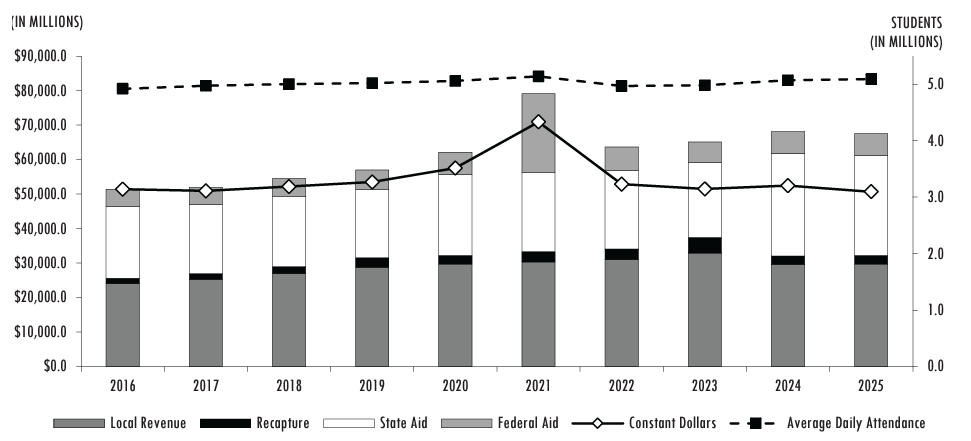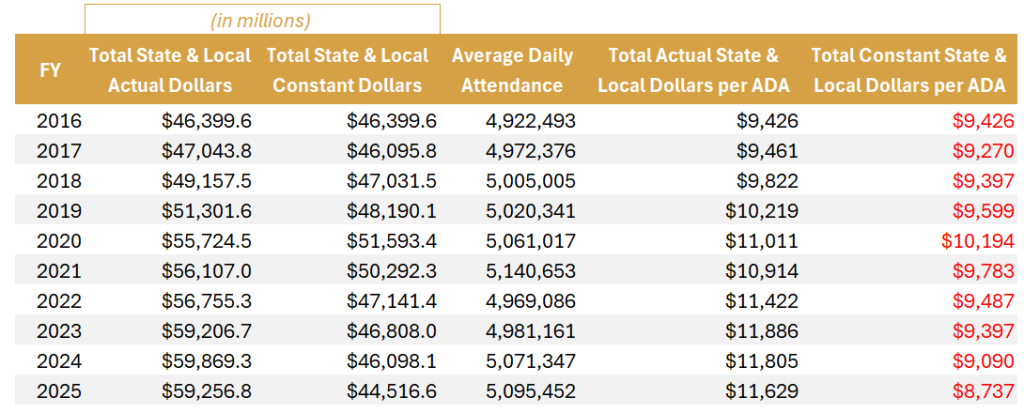The Legislative Budget Board (LBB) recently released their Fiscal Size-Up report for the 2024-25 biennium. This report provides all sorts of useful information about the state government and the money it spends (or, more appropriately, doesn’t spend).
One key figure in the report provides an overview of public education funding going back to fiscal 2016 (i.e. the 2015-16 school year). Importantly, this analysis includes inflation-adjusted data and the results shine a light on what school district administrators across the state have been communicating to their elected officials since HB 3 passed back in 2019.
In short: funding levels have fallen well below pre-HB 3 levels when adjusting for inflation.

Source: Legislative Budget Board, Fiscal Size-Up 2024-25 Biennium, page 221
As shown in the figure above, state aid increased in FY 2020 (school year 2019-20) with the passage of HB 3. That year, total actual state and local funding increased by $4.4 billion over the prior year. The legislation required that 30 percent of districts’ per student funding increases be used for teacher compensation raises.
School districts then received unprecedented levels of federal aid with the passage of ESSER I, II and III. Other federal funding such as Title I was also increased around that time. In fiscal year 2020, federal funding increased to $23.0 billion, according to the LBB.
School districts were encouraged by TEA to use this funding to pay for ongoing expenditures and to “bank” the saved local dollars in fund balance, in order to extend the life of the grant. Districts were also encouraged to use ESSER funds to provide additional tutoring for students to offset learning loss that occurred due to the pandemic, not to mention needing to completely transform their educational delivery model from in-person to online.
Beginning in fiscal year 2022, the LBB analysis appears to show that overall inflation-adjusted funding has returned to pre-HB 3 levels (look at the line with white diamond markers in the graph above).
It is important to note, however, that the LBB’s figure includes $4.0 billion of funding for the 2024-25 biennium that has yet to be authorized by the Legislature. This funding was appropriated by state budget writers, but was never authorized to be spent due to disagreements over vouchers that played out over the course of several special sessions. With an additional special session unlikely, there is little chance schools will see this money during the 2024-25 biennium.
To provide a more accurate picture, MoakCasey staff have prepared the table below using the LBB’s data. This analysis looks just at state and local funding (including recapture), removes the unauthorized funding increases mentioned above (50 percent from each year of the biennium), and provides a per ADA figure for reference.

Based on this analysis, inflation-adjusted state and local funding per ADA is currently projected for the 2023-24 school year (fiscal 2024) to be $9,090. As inflation continues to increase over the next school year, that number drops to $8,737. This represents a nearly $1,460 decline compared to what schools received in fiscal 2020, the first year of HB 3.
Regardless of what happens with the voucher debate next legislative session, public education leaders must continue to show state lawmakers the impact their inaction is having on their budgets. We look forward to working alongside you all this session to ensure that the state makes good on its constitutional obligation to adequately fund the public education system.
